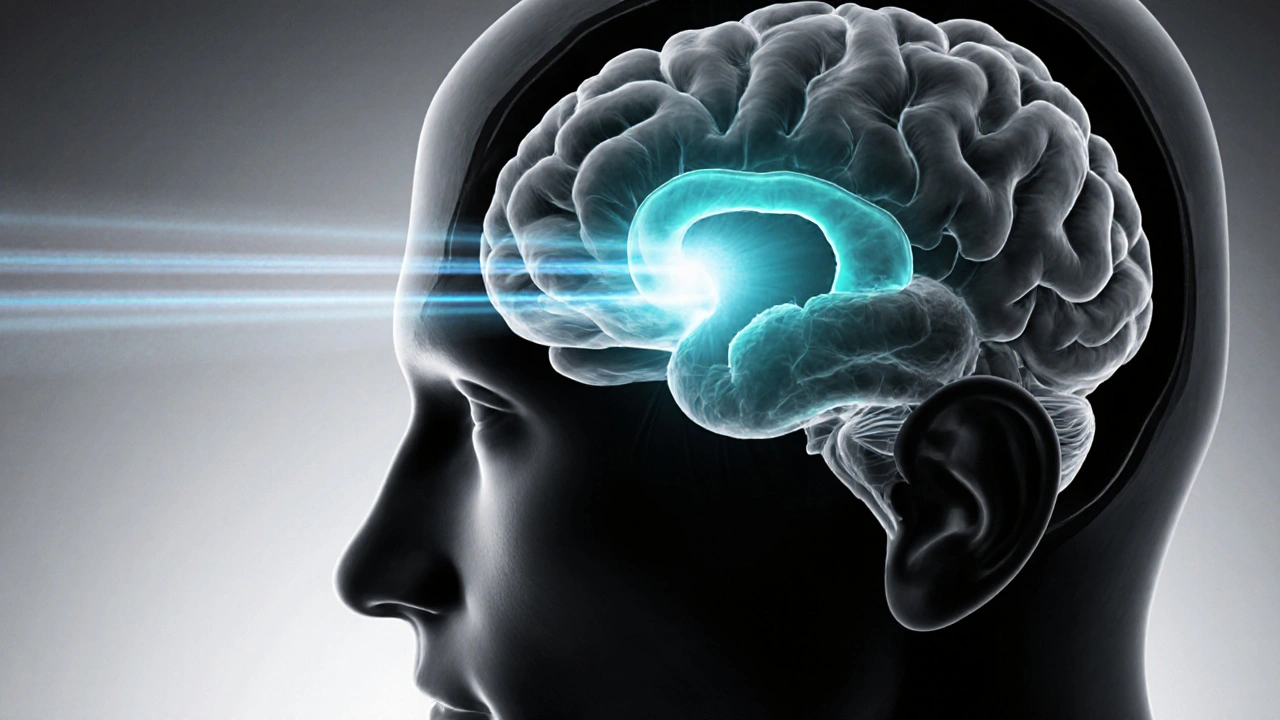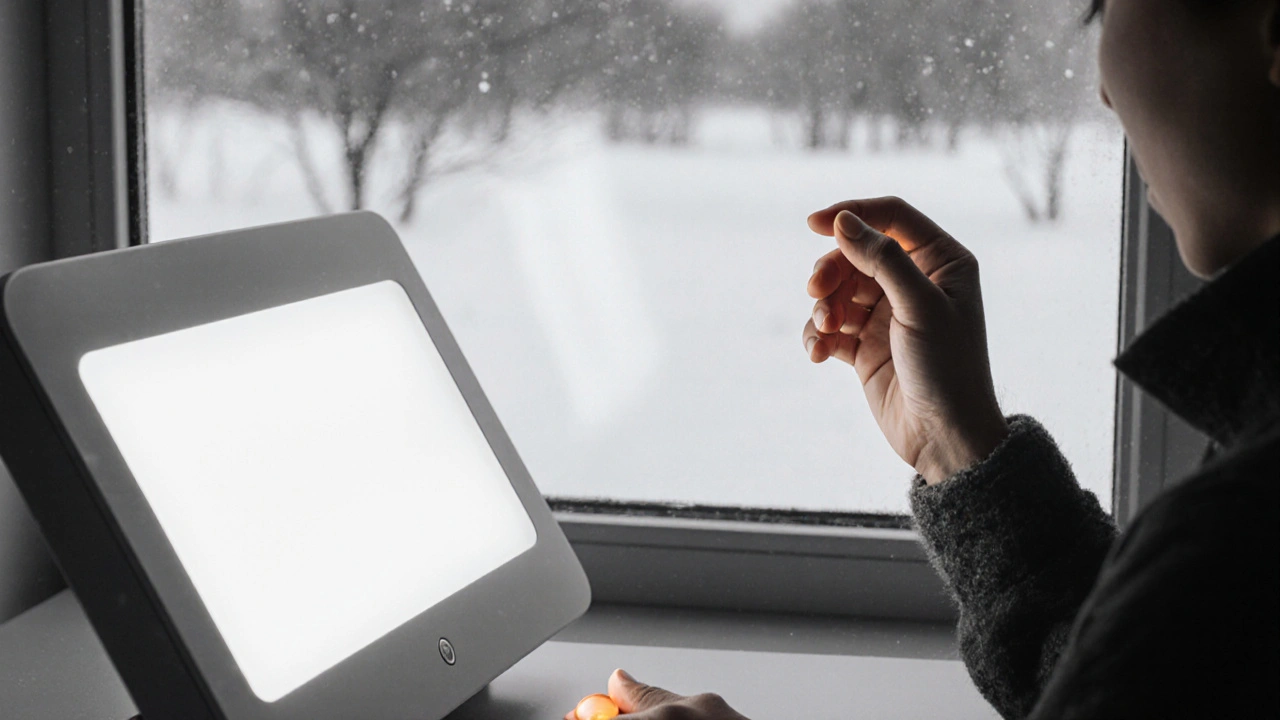Melatonin and Seasonal Affective Disorder: How Hormones Influence Winter Blues

Circadian Rhythm Assessment Tool
This tool assesses how well your sleep-wake cycle aligns with natural light patterns. Disrupted circadian rhythms are a key factor in Seasonal Affective Disorder. Enter your typical sleep times and morning light exposure to see if your rhythm might be contributing to winter blues.
Quick Summary
- Melatonin is a sleep‑regulating hormone that reacts to daylight changes.
- Seasonal Affective Disorder (SAD) is a mood dip that follows the same light pattern.
- Disrupted circadian rhythms are the hidden link between melatonin and SAD.
- Light therapy and timed melatonin supplements are the two most evidence‑based interventions.
- Combining good sleep hygiene with natural light exposure usually yields the best results.
When the days grow short, Melatonin is a hormone produced by the pineal gland that helps regulate our sleep‑wake cycle often gets blamed for the winter slump. At the same time, Seasonal Affective Disorder is a mood condition that spikes when daylight drops below a certain threshold. This article unpacks how these two pieces fit together, what the science says, and what you can actually do when the darkness starts to affect your mood.
Understanding Melatonin
Melatonin is not a magic sleep pill; it’s the body’s natural cue that night is coming. The pineal gland ramps up production after sunset, peaking around 2-4a.m. Light hitting the retina sends a signal to the suprachiasmatic nucleus (SCN), the brain’s master clock, which then tells the gland to dial melatonin down.
Key attributes of melatonin:
- Production trigger: darkness
- Peak level: 80-120pg/mL in healthy adults
- Half‑life: 30-50minutes
- Primary role: synchronizing the sleep‑wake cycle
When darkness stretches longer in winter, melatonin can stay elevated later into the morning, which throws off the timing of other hormones-especially serotonin, the brain’s feel‑good chemical.
What Is Seasonal Affective Disorder?
SAD is a form of major depressive disorder that follows a seasonal pattern, usually appearing in late fall and disappearing in spring. Symptoms include low energy, increased sleep, carbohydrate cravings, and a pervasive low mood.
According to the American Psychiatric Association, about 5% of adults in the U.S. experience SAD, with higher rates in northern latitudes (think Canada and Scandinavia). The condition isn’t just “winter blues”; it’s a measurable shift in neurotransmitter activity and hormonal balance.
How Melatonin Links to SAD
The connection boils down to three intertwined mechanisms:
- Circadian misalignment: Shorter daylight means the SCN receives weaker light signals, delaying the internal clock. This pushes melatonin production later, which in turn shifts sleep timing and can make you feel groggy during daylight hours.
- Serotonin suppression: Melatonin and serotonin share a precursor (tryptophan). When melatonin dominates, serotonin synthesis drops, leading to lower mood.
- VitaminD deficiency: Less UVB exposure reduces vitaminD, which also modulates serotonin pathways. While not a direct melatonin effect, the triad often appears together in winter.
In short, when melatonin stays high past the usual wake‑up window, it throws a wrench into the brain’s chemistry that helps keep us upbeat.

Assessing Your Own Rhythm
Before jumping to supplements, try a quick self‑audit. Grab a notebook or a free sleep‑tracking app and record the following for two weeks:
- Bedtime and wake‑time (to the nearest 15minutes)
- Morning daylight exposure (minutes spent outdoors before 10a.m.)
- Mood rating on a 1‑10 scale each evening
- Any cravings for carbs or caffeine
If you notice a consistent delay in sleep onset (e.g., you’re not falling asleep until after 1a.m.) paired with a dip in mood scores during the same window, a circadian shift is likely at play.
Treatment Options: Light Therapy vs. Melatonin Supplements
Both approaches aim to reset the internal clock, but they do it from opposite ends-one by flooding the eyes with bright light, the other by tweaking hormone timing.
| Aspect | Melatonin Supplements | Light Therapy |
|---|---|---|
| Mechanism | Shifts melatonin onset earlier | Increases retinal light signal to SCN |
| Typical Dosage/Duration | 0.3‑5mg taken 30‑60min before desired bedtime | 10,000‑lux box for 20‑30min each morning |
| Evidence of Efficacy | Modest improvement in sleep timing; mood benefit varies | Strong evidence - 60‑70% experience mood lift |
| Side Effects | Drowsiness, vivid dreams, rare morning grogginess | Eye strain, headache, occasional mania in bipolar patients |
| Cost (2025 USD) | $10‑$30 for a month’s supply | $150‑$400 for a quality light box |
| Best For | People with delayed sleep phase, who can’t use a light box | Those with classic SAD symptoms and good morning routine |
Many clinicians recommend a hybrid approach: a light box first thing in the morning to anchor the clock, plus a low‑dose melatonin at night to fine‑tune bedtime.
Practical Tips to Manage SAD
Even if you decide against supplements, simple lifestyle tweaks can keep the darkness from taking over:
- Morning light exposure: Step outside for at least 15minutes within an hour of waking. Even a cloudy day provides enough photons to signal the SCN.
- Limit evening light: Switch off bright screens at least two hours before bed. Use amber‑filtered glasses if you need to work late.
- Consistent sleep schedule: Go to bed and wake up at the same times daily, even on weekends.
- Exercise early: A 30‑minute walk or workout before noon boosts serotonin and helps regulate melatonin.
- VitaminD supplementation: 1,000-2,000IU daily in winter can support mood, especially if blood levels are low.
- Balanced diet: Include complex carbs, omega‑3 fatty acids, and tryptophan‑rich foods (turkey, nuts) to nourish serotonin pathways.
These habits reinforce the natural light‑dark cycle, making the body less reliant on pharmaceutical fixes.

Common Pitfalls & When to Seek Professional Help
Even the best‑crafted plan can go sideways. Watch out for these red flags:
- Persistent low mood despite consistent light exposure and sleep hygiene (more than four weeks)
- Thoughts of self‑harm or severe anhedonia
- New‑onset anxiety, panic attacks, or insomnia that worsens at night
- Significant weight gain or loss (>5% body weight in a month)
If any of these appear, book an appointment with a mental‑health professional. They can rule out other depressive disorders, adjust medication, or refer you to a chronobiology specialist.
Bottom Line
Understanding the dance between melatonin and Seasonal Affective Disorder gives you a roadmap to feel better when winter sets in. By aligning your environment with your biology-through light, timing, and healthy habits-you can keep the seasonal slump at bay.
Frequently Asked Questions
Can I take melatonin every night during winter?
Short‑term use (a few weeks) is generally safe for most adults. Long‑term nightly use should be discussed with a doctor, especially if you have depression, bipolar disorder, or are on blood‑thinning medication.
How long does it take for light therapy to work?
Most people notice a mood lift within 3-5 days of daily 20‑minute sessions. Full benefits often appear after 2-3 weeks of consistent use.
Is there a best time of day to take melatonin for SAD?
Take it 30‑60minutes before your target bedtime, ideally at the same clock time each night. This helps signal the body to shift the internal clock earlier.
What if I live in a place with 24‑hour daylight in summer?
Even in summer, maintaining a regular sleep schedule matters. Use blackout curtains in the evening to simulate darkness and keep melatonin production on schedule.
Are there natural foods that boost melatonin?
Cherries, walnuts, and oats contain small amounts of melatonin. While they won’t replace supplements, they can modestly support nighttime melatonin levels when eaten a few hours before bed.
Wow, this article really nails the whole melatonin‑SAD connection!!! I love how it breaks down the circadian rhythm stuff-makes it sooo clear!!!
Great point, Steve! The way you’ve highlighted the light‑therapy evidence is spot‑on, and I’d add that tracking sleep patterns can really help people fine‑tune their melatonin schedule.
Honestly, all this talk about melatonin is just another excuse for lazy folks to avoid real work-America needs to toughen up and get out in the daylight without relying on fancy light boxes.
I've been reading your take on melatonin and Seasonal Affective Disorder, and I feel compelled to share how deeply intertwined my own emotional landscape has become with the shifting shadows of winter, something that I confess many people hesitate to admit because it feels almost like betraying a personal secret. The early evenings seem to stretch endlessly, and my mind begins to wander into corridors of melancholy that echo the low‑light environment outside. I notice that my appetite for carbohydrates spikes, and the cravings feel as though they are trying to compensate for a serotonin deficit that I can barely name. While I understand the biochemical explanations, the lived experience feels like a slow, creeping fog that settles over every thought, making even simple tasks feel burdensome. My attempts to follow the light‑therapy schedule have been sporadic, largely because my work hours often clash with the recommended morning exposure, and this mismatch has left me frustrated. I have tried low‑dose melatonin supplements, but the timing is tricky; taking them too early makes me feel drowsy at inappropriate moments, while taking them too late disrupts my sleep even further. The suggestion to keep a sleep diary was useful initially, yet maintaining it consistently proved challenging when my motivation waned during the darker weeks. Moreover, the emphasis on exercise before noon resonates with me, but the cold weather reduces my willingness to go outside, creating another barrier to compliance. Through all this, I have sensed a subtle pressure to “just get over it,” as if my struggle is a mere lack of willpower rather than a complex neurochemical shift. This feeling of being misunderstood adds an emotional weight that compounds the physiological symptoms, creating a feedback loop that intensifies the depressive state. I also wonder about the role of social support, because isolation during winter months can magnify the sense of despondency, yet the article barely touches on community interventions. Finally, the notion of integrating behavioral strategies with light exposure feels logical, but the practical roadmap for doing so remains vague in the current discussion. In sum, while the scientific overview is thorough, the personal nuances and day‑to‑day hurdles deserve more attention for a truly holistic approach. I hope future guidelines will incorporate these lived‑experience insights to make treatment more accessible.
Valerie, your description captures the complex emotional impact very well; from a coaching perspective, integrating consistent morning light exposure with reflective journaling can gradually re‑align the internal clock and improve mood stability.
It is paramount, especially for professionals who maintain demanding schedules, to adopt a highly structured approach to melatonin management, ensuring that dosage, timing, and environmental cues are harmonized with evidence‑based protocols.